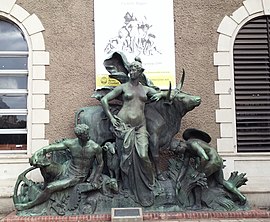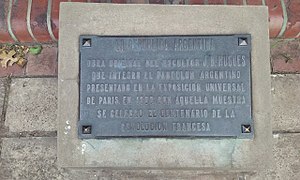33:
107:
260:. The pavilion was made of iron, and could be easily disassembled. When there were no buyers, it was decided to bring it to Buenos Aires. Some parts were lost in a storm during the transatlantic crossing, but it arrived in Buenos Aires in acceptable condition. A bidding contest was held to see who wanted to rebuild it and exploit the concession, which was won by an Englishman who used the pavilion for various types of exhibitions. In 1910, at the centenary of the
274:
314:, 'museum and archive of technology and education Lorenzo Raggio', found that the former owner (Isidoro Adrets, a soldier and a blacksmith), had bought the remains of the Argentine Pavilion in 1945. The elements of the main nave of the pavilion had not been destroyed, but were buried in a sector of the
340:
in
Argentina. At its feet are two human figures: one the right that is harvesting grain (representing the agriculture that is main source of the wealth of the country) and one on the left; a man seated on an anvil between gears (that symbolize industry) holding a locomotive, personifying the progress
212:
At the Paris
Universal Exhibition held in 1889, 35 countries built enormous pavilions that were used by each nation to show its progress and cultural level. Each pavilion tried to represent the wealth of the participant nation. Argentina was one of the invited countries, which gave an opportunity for
247:
conserves the original plaster model of the sculpture, measuring 84 cm x 122.3 cm x 33 cm. It was given to the museum in 1946 by
Ignacio Pirovano, to commemorate his mother María Rosa Lezica Alvear of Pirovano. Dr. Pirovano inherited the sculpture from his grandfather, Ricardo de
281:
The bronze sculptural groups that decorated the four corners of the pavilion were installed by the Buenos Aires city authorities in diverse points of the city, whilst the main sculpture was placed at its current location next to the building of the
228:. A demountable construction of iron was specified so as to be able to move the pavilion to Buenos Aires after the exhibition ended. The work of construction was awarded to the renowned French architect
221:, which was the entrance to the exhibition. The Argentine Pavilion was designed in a European style, as compared to the Mexican and the Brazilian pavilions that emphasized their Latin American heritage.
213:
its political leadership to show the economic strength of a nation that had experienced major modernisation and transformation in the preceding twenty years. The
Argentine Pavilion was in the
151:
256:
After the
Universal Exhibition, the Argentine delegation in Paris tried to sell the pavilion because of the precarious state of the Argentine economy after the
17:
270:(San Martín square) in front of the National Museum of Fine Arts. The Pavilion was dismantled between the 1932 and 1934, and eventually sold as scrap.
224:
To build the
Argentine Pavilion, the national government delegated the task of organizing a contest to an ad hoc committee chaired by the writer
244:
461:
304:, 'Solana Factory of Cars and Carriages' were discovered. Recent investigations carried out by a group of researchers of the
456:
266:
336:(a traditional symbol of liberty) and garments waving in the wind. At her back is a bull that symbolises the growing
76:
54:
47:
437:
418:
196:
143:
305:
283:
41:
381:
316:
58:
321:
192:
117:
8:
248:
Lezica y
Thompson, who was a member of the Argentine commission of the Paris exhibition.
225:
433:
414:
337:
332:
The sculpture is a feminine figure that personifies the
Argentine Republic, with a
127:
195:
by Jean-Baptiste Hugues, that was a central part of the
Argentine Pavilion at the
264:, the pavilion was recovered by the national government in order to place it in
106:
261:
450:
277:
Monument plate of the sculpture at its location at the
Escuela Técnica Raggio
257:
214:
166:
153:
333:
229:
218:
324:. Despite this, there have been no efforts to locate and display them.
308:
Faculty of Architecture, Design and Urbanism, and another group of the
295:
273:
237:
243:
Hugues sculpted an original work in bronze for the pavilion. The
398:
El pabellón argentino en la exposición universal de París 1889
298:, some remains of the Pavilion that had become part of the
400:(in Spanish). Buenos Aires: Museo Escuela Técnica Raggio.
357:
Museo Nacional de Bellas Artes (Buenos Aires), inv. 6695
217:; a privileged place because of its nearness to the
191:(Spanish for 'The Argentine Republic') is a
251:
235:
448:
309:
299:
184:
311:Museo Archivo Tecno Educativo Lorenzo Raggio
289:
430:Rodín en el Museo Nacional de Bellas Artes
105:
207:
77:Learn how and when to remove this message
272:
40:This article includes a list of general
427:
14:
449:
432:. Buenos Aires: Fundación Antorchas.
404:
379:
197:Universal Exhibition of Paris in 1889
301:Fábrica Solana de Carros y Carruajes
26:
24:
232:, who came second in the contest.
46:it lacks sufficient corresponding
25:
18:La República Argentina (escultura)
473:
294:In 1997, in the neighbourhood of
462:Sculptures of women in Argentina
252:The relocation of the sculptures
31:
457:Outdoor sculptures in Argentina
380:Colom, Roger (16 March 2015).
360:
351:
327:
13:
1:
373:
245:National Museum of Fine Arts
7:
405:Gelós, Andrés, ed. (2004).
10:
478:
411:Sculptures of Buenos Aires
306:University of Buenos Aires
202:
428:Amarger, Antoine (2001).
141:
133:
123:
113:
104:
96:
91:
407:Buenos Aires escultórica
344:
320:in the neighbourhood of
290:The fate of the pavilion
61:more precise citations.
317:Parque Tres de Febrero
310:
300:
284:Escuela Técnica Raggio
278:
236:The sculpture and its
208:The Argentine Pavilion
187:La República Argentina
185:
99:The Argentine Republic
92:La República Argentina
413:]. Tiago Biavez.
341:of a modern country.
276:
382:"Un sueño argentine"
193:monumental sculpture
118:Jean-Baptiste Hugues
167:34.5360°S 58.4661°W
163: /
279:
226:Eugenio Cambaceres
172:-34.5360; -58.4661
262:Revolution of May
182:
181:
87:
86:
79:
16:(Redirected from
469:
443:
424:
401:
393:
391:
389:
367:
364:
358:
355:
338:animal husbandry
313:
303:
267:Plaza San Martín
190:
178:
177:
175:
174:
173:
168:
164:
161:
160:
159:
156:
146:
128:Bronze sculpture
109:
89:
88:
82:
75:
71:
68:
62:
57:this article by
48:inline citations
35:
34:
27:
21:
477:
476:
472:
471:
470:
468:
467:
466:
447:
446:
440:
421:
396:
387:
385:
376:
371:
370:
365:
361:
356:
352:
347:
330:
292:
254:
241:
210:
205:
171:
169:
165:
162:
157:
154:
152:
150:
149:
142:
83:
72:
66:
63:
53:Please help to
52:
36:
32:
23:
22:
15:
12:
11:
5:
475:
465:
464:
459:
445:
444:
438:
425:
419:
402:
394:
375:
372:
369:
368:
366:Andalgalá 1475
359:
349:
348:
346:
343:
329:
326:
291:
288:
258:crisis of 1890
253:
250:
240:
234:
209:
206:
204:
201:
180:
179:
147:
139:
138:
135:
131:
130:
125:
121:
120:
115:
111:
110:
102:
101:
94:
93:
85:
84:
39:
37:
30:
9:
6:
4:
3:
2:
474:
463:
460:
458:
455:
454:
452:
441:
435:
431:
426:
422:
416:
412:
408:
403:
399:
395:
383:
378:
377:
363:
354:
350:
342:
339:
335:
325:
323:
319:
318:
312:
307:
302:
297:
287:
285:
275:
271:
269:
268:
263:
259:
249:
246:
239:
233:
231:
227:
222:
220:
216:
215:Champ de Mars
200:
198:
194:
189:
188:
176:
148:
145:
140:
136:
132:
129:
126:
122:
119:
116:
112:
108:
103:
100:
95:
90:
81:
78:
70:
60:
56:
50:
49:
43:
38:
29:
28:
19:
429:
410:
406:
397:
386:. Retrieved
384:(in Spanish)
362:
353:
334:Phrygian cap
331:
315:
293:
280:
265:
255:
242:
230:Albert Ballu
223:
219:Eiffel Tower
211:
186:
183:
137:Buenos Aires
98:
73:
64:
45:
328:Description
170: /
144:Coordinates
67:August 2016
59:introducing
451:Categories
439:9509837113
420:9879254155
374:References
158:58°27′58″W
155:34°32′10″S
42:references
388:23 August
296:Mataderos
97:English:
238:maquette
134:Location
322:Palermo
203:History
55:improve
436:
417:
124:Medium
114:Artist
44:, but
409:[
345:Notes
434:ISBN
415:ISBN
390:2015
453::
286:.
199:.
442:.
423:.
392:.
80:)
74:(
69:)
65:(
51:.
20:)
Text is available under the Creative Commons Attribution-ShareAlike License. Additional terms may apply.

